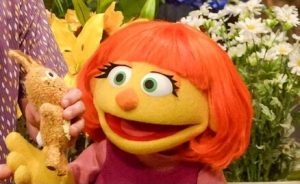After decades of misinformation and stigma about autism permeating our airwaves, now the oft-misunderstood disease has landed in the place where children learn about everything: “Sesame Street.”
Beginning last week, a Muppet character with autism named Julia joined the historic neighborhood best known for being the “gold standard in educational children’s television,” as Hank Stuever of The Washington Post described the show.

“Viewers meet Julia as she is coloring with Elmo, Abby Cadabby and their grown-up friend Alan (Alan Muraoka), who owns Hooper’s store,” Stuever writes. “Big Bird drops by and introduces himself to Julia, but she won’t talk to him. He wonders whether she’s shy, because, he says, ‘I can feel shy sometimes too.’”
Of course, the wizardly decent people of “Sesame Street” plainly explain Julia is autistic and doesn’t always answer right away. And Big Bird has no problem with that.
“Thus ‘Sesame Street’ has once again done its job with little fanfare or self-congratulatory narrative,” Stuever writes. “The only lesson here is the same message ‘Sesame Street’ has been transmitting since 1969: We all belong here, we are all friends, and sharing is the best way to get along.”
Autism Awareness Month: Help Spread a Message of Hope
According to the website AutismSpeaks.org, autism falls on a spectrum of disorders characterized by challenges with social skills, repetitive behaviors, speech and nonverbal communication, as well as by unique strengths and differences.

“We now know that there is not one autism but many types, caused by different combinations of genetic and environmental influences,” according to the website. “The term ‘spectrum’ reflects the wide variation in challenges and strengths possessed by each person with autism.”
Representations of autism in the media have been proliferating in recent years. In a blog post on the Seattle Children’s Hospital Research Foundation website, David Eaton writes, “The classic example of autism that pops into many people’s minds is Dustin Hoffman in ‘Rain Main.’”
“Certainly, this is ONE representation, but most people would say, ‘That’s not my kid.’ How can we expect autism to be portrayed to our liking when we think of the mantra, ‘If you’ve seen one kid with autism, you’ve seen one kid with autism?’” Eaton writes.
Related: 5 Myths About Autism You Should Know

Stuever takes an optimistic view. “Watching Julia acquaint herself with the world of ‘Sesame Street,’ and vice-versa, I couldn’t help but notice how shiny and new the show looks since the HBO deal,” he wrote about the recent acquisition. “‘Sesame Street’ has always evolved with the time and long ago shed some of the chill, lo-fi vibe that defined its earliest days.”
He calls “Sesame Street” authentic and a “national treasure,” adding, “it’s impossible not to notice that the neighborhood has changed.”
Next Story: Brain Scans Could Spot Autism Even Sooner in Infants
A professional journalist nearly 30 years, David Heitz started his career at the Quad-City Times in Davenport, Iowa before moving to Los Angeles. He led the Glendale News-Press to best small daily newspaper in the state (CNPA) as managing editor and also worked as executive news editor of the Press-Telegram. He worked briefly as deputy news editor of the Detroit News before returning to the Quad-Cities, where he has worked as a freelance medical writer since 2012 for several national websites. He recently purchased his childhood home and says he truly is “living the dream.”


![How To: ‘Fix’ Crepey Skin [Watch]](https://cdn.vitalupdates.com/wp-content/uploads/2017/05/bhmdad.png)












